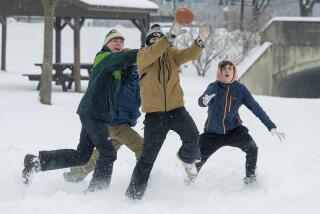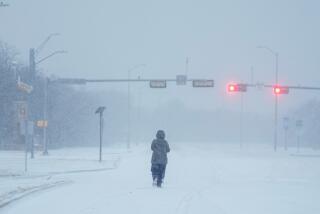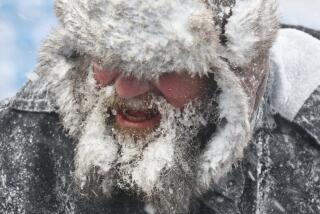What is a âpolar vortexâ and why is it so dangerous?
As of Monday afternoon, the Midwest was battling uncommonly frigid weather that threatened to break some all-time-low temperature records. January is typically cold, but not this cold, with several Midwestern cities such as Chicago gripped by daytime temperatures well below zero.
So whatâs happening?
A huge mass of arctic air has slipped away from the North Pole, settled over the U.S. and made everything really, really cold, meteorologists told The Times. You may know the phenomenon by a phrase youâve seen in headlines lately: the ominous-sounding âpolar vortex.â
âItâs not really a phrase I like -- it makes it sound a lot worse than what it actually is,â said Todd Heitkamp, a warning coordination meteorologist for the National Weather Service in Souix Falls, S.D. âThis has happened before.â Most recently in the 1990s, he said.
PHOTOS: Deep freeze in the Mid West
What is a polar vortex?
Ryan Maue, a Florida-based meteorologist for the private weather service WeatherBELL, described it as a âlobeâ of dense, cold air thatâs normally bound in by a jet stream; this one detached from over the North Pole and brought a whole lot of wind with it.
âThe polar vortex isnât this entity like a hurricane or norâeaster that develops and goes away. Itâs a normal feature thatâs part of the polar climate,â Maue told The Times.
Over the North Pole, Maue explained, cold air typically forms at night where clear skies allows heat to escape into space.
PHOTOS: Deep freeze in the Mid West
âDay after day after day, these pools of air formâ near the pole, Maue said. âThereâs always cold air up there, if the Arctic is left to its own devices.â
And, because of a âmultitude of factors,â Maue said, a mass broke south and headed toward the U.S.
The National Weather Serviceâs Heitkamp likened the effect to a large mass of cold building up over the North Pole and getting âflushedâ south.
âThe jetstream just shifts enough,â Heitkamp said, and a high-pressure front âjust moves in over the upper Midwest, and it just sits in place, and it allows the cold air to spread over the entire upper Midwest.â
PHOTOS: Deep freeze in the Mid West
Wind has accompanied the cold: On Monday morning, the National Weather Service forecast wind chills of more than 30 degrees below zero to sweep an area as far west as Montana, as far east as New York and as far south as Missouri.
Why is this all so dangerous?
At those temperatures, Heitkamp warned, exposed flesh can freeze in five minutes, and some vehicles may not start.
âIf a person isnât dressed properly, and they donât have a winter survival kit in their vehicle, and if they arenât prepared, theyâll have to deal with the consequences thereafter,â Heitkamp said. âWe have a lot of vehicles right now that are not starting.â
While those kind of precautions may be familiar to upper Midwesterners, they may come as a surprise to Americans used to warmer Januaries.
âIt affects people that arenât used to cold right now. Iâm in Florida right now, and theyâre issuing a wind chill advisory because itâs going to go below freezing,â said Maue, speaking by phone from Tallahassee and calling it a once-in-a-decade event.
When will it be over?
The polar mass is expected to warm slightly as it moves over the East Coast by Monday night, before finally blowing out to sea.
âItâs like flipping the switch and weâre back to more mild conditions for January,â Maue said.
Heitkamp added, âWeâre just telling people to minimize their time outdoors, pay attention to the forecast, and this too shall pass.â
ALSO:
PHOTOS: Deep freeze in the Mid West
News photographs reunite family with missing son
Cronut-crazed New Yorkers brave bad weather for pastry
More to Read
Sign up for Essential California
The most important California stories and recommendations in your inbox every morning.
You may occasionally receive promotional content from the Los Angeles Times.











